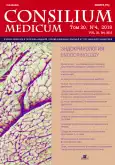New technologies in diabetes mellitus management: from theory to practice
- Authors: Barsukov I.A1, Demina A.A1
-
Affiliations:
- M.F.Vladimirskiy Moscow Regional Clinical Institute
- Issue: Vol 20, No 4 (2018)
- Pages: 24-28
- Section: Articles
- URL: https://journals.rcsi.science/2075-1753/article/view/94992
- ID: 94992
Cite item
Full Text
Abstract
Full Text
##article.viewOnOriginalSite##About the authors
I. A Barsukov
M.F.Vladimirskiy Moscow Regional Clinical Institute
Email: palantirr@inbox.ru
канд. мед. наук, ст. науч. сотр. отд-ния терапевтической эндокринологии 129110, Russian Federation, Moscow, ul. Shchepkina, d. 61/2
A. A Demina
M.F.Vladimirskiy Moscow Regional Clinical Institute
Email: annagalitskova@gmail.com
аспирант каф. эндокринологии ФУВ 129110, Russian Federation, Moscow, ul. Shchepkina, d. 61/2
References
- Глобальный доклад по диабету. ВОЗ, 2016.
- Tietz Fundamentals of Clinical Chemistry, 4th Edition. Editors Burtis and Ashwood. W.B. Saunders Company, 1996; p. 43-52.
- Diabetes Association. Diabetes and classification of diabetes mellitus. Diabetes care 2004; 27 (Suppl. 1): S5-S10.
- Тест-системы для диагностики in vitro. Требования к системам мониторинга глюкозы в крови для самоконтроля при лечении сахарного диабета [Электронный ресурс]: ГОСТ Р ИСО 15197-2015. Введ. 2016-06-01. http://docs.cntd.ru/document/1200120137. (Дата обращения 17.10.2017)
- Wahl P.W, Savage P.J, Psaty B.M et al. Diabetes in older adults: comparison of 1997 American Diabetes Association classification of diabetes mellitus with 1985 WHO classification. Lancet 1998; 352: 1012-15.
- Древаль А.В., Мисникова И.В., Барсуков И.А. и др. Распространенность сахарного диабета 2 типа и ранних нарушений углеводного обмена среди взрослого населения Московской области. Ожирение и метаболизм. 2008; 2 (15): 11-6.
- Сахарный диабет 1 типа: реалии и перспективы. Под ред. И.И.Дедова, М.В.Шестаковой. М.: Мед. информ. агентство, 2016; с. 380-93.
- Pickup J.C, Keen H. Continuous subcutaneous insulin infusion at 25 years. Diabetes Care 2002; 25: 593-8.
- Bode B.W, Sabbah H.T, Gross T.M et al. Diabetes management in the new millennium using insulin pump therapy. Diabetes Metab Res Rev 2002; 18 (Suppl. 1): S14-20.
- Pickup J, Mattock M, Kerry S. Glycemic control with continuous subcutaneous insulin infusion compared with intensive insulin injections in patients with type 1 diabetes. BMJ 2002; 324: 705-8.
- Hoogma R.P, Hammond P.J, Gomis R et al. Comparison of the effects of continuous subcutaneous insulin infusion (CSII) and NPH-based multiple daily insulin injections (MDI) on glycaemic control and quality of life. Diabet Med 2006; 23: 141-7.
- Rodriguеs A.S, Reid H.A, Ismail K et al. Indications and efficacy of continuоus subcutaneous insulin infusion (CSII) therapy in Type 1 diabetes mellitus: a clinical audit in a specialist service. Diabet Med 2005; 22 (7): 842-9.
- American Diabetes Association. Standards of medical care in diabetes - 2017. Diabetes Care 2017; 40 (Suppl. 1): S1-S2.
- Алгоритмы специализированной медицинской помощи больным сахарным диабетом. Под ред. И.И.Дедова, М.В.Шестаковой, А.Ю. Майорова. Вып. 8. М.: УП Принт, 2017.
- Древаль А.В., Барсуков И.А., Шестакова Т.П. и др. Помповая инсулинотерапия и непрерывное мониторирование гликемии: опыт клинической практики в рамках оказания высокотехнологичной медицинской помощи. РМЖ. 2017; 1: 3-8.
- Walsh J et al. Guidelines for insulin dosing in continuous subcutaneous insulin infusion using new formulas from a retrospective study of individuals with optimal glucose levels. J Diabetes Sci Technol 2010; 4: 1174-81.
- Klonoff D.C. Continuous glucose monitoring: roadmap for 21st century diabetes therapy. Diabetes Care 2005; 28: 1231-9.
- Древаль О.А. Непрерывное мониторирование гликемии в оценке эффективности лечения сахарного диабета. Автореф. дис.. канд. мед. наук. М., 2013.
- Dunne N., Viggiani M.T. Accuracy Evaluation of CONTOUR_PLUS Compared With Four Blood Glucose Monitoring Systems. Diabetes Ther 2015; 6: 377-88.
- Baum J.M et al. Improving the Quality of Self-Monitoring Blood Glucose Measurement: A Study in Reducing Calibration Errors. Diab Tech Ther 2006; 8 (3): 347-57.
- Koschinsky T et al. Glucose monitoring at the arm - Risky delays of hypoglycemia and hyperglycemia detection. Diabetes Care 2002; 25: 956-60.
- Engelgau M.M, Narayan V, Herman W. Screening for type 2 diabetes. Diabetes care 2000; 23 (10): 1563-80.
- Lawrence J, Robinson A. Screening for diabetes in general practice. Prev Cardiol 2003; 6 (2): 78-84.
Supplementary files






